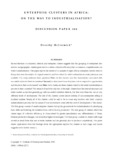| dc.contributor.author | McCormick, Dorothy | |
| dc.date.accessioned | 2018-07-06T13:51:02Z | |
| dc.date.available | 2018-07-06T13:51:02Z | |
| dc.date.issued | 1998-01-25 | |
| dc.identifier.citation | McCormick, D. (1998) Enterprise Clusters in Africa: On the Way to Industrialisation? | en |
| dc.identifier.isbn | 1 85864 227 2 | |
| dc.identifier.uri | https://opendocs.ids.ac.uk/opendocs/handle/20.500.12413/13870 | |
| dc.description.abstract | Recent literature on industrial districts and enterprise clusters suggests that the grouping of enterprises into sectoral and geographic clusters gives rise to a certain collective efficiency that can enhance competitiveness and foster industrialisation.
This paper reports the results of an analysis of eight African enterprise clusters: three in Kenya that were the subject of original research, and five others for which substantial secondary literature was available. The study addresses three questions:
Do the clusters have the characteristics associated with successful industrial districts elsewhere?
To what extent have they been able to respond to opportunities and shocks in their environment?
How closely are these clusters linked to the wider industrialisation process in their countries?
The research found that only two of the eight clusters have the internal structure and wider market access that generally go with successful industrial districts, but that even these two are at very different levels of development. The rest of the clusters consist almost entirely of microenterprises selling in localised markets. Nearly all of the clusters could be said to be in some way involved with their country's industrialisation process, but the nature of that involvement varies with the level of development of the cluster.
The first group consists of small-enterprise clusters that lay the groundwork for industrialisation by developing basic skills and fostering the transition from craft to factory production. The next group of clusters, which has clearer signs of collective efficiency, is characterised by greater specialisation and differentiation of firms, bilateral production linkages, and somewhat higher technologies. The final group consists of clusters with large as well as small firms that aim at wider markets and are generally able to produce competitively.
The paper draws implications from the findings about the appropriate support for clusters at each stage, and makes suggestions for further research. | en |
| dc.language.iso | en | en |
| dc.publisher | Institute of Development Studies | en |
| dc.relation.ispartofseries | IDS Discussion Paper;367 | |
| dc.rights.uri | http://www.ids.ac.uk/files/dmfile/IDSOpenDocsStandardTermsOfUse.pdf | en |
| dc.subject | Trade | en |
| dc.title | Enterprise Clusters in Africa: On the Way to Industrialisation? | en |
| dc.type | IDS Discussion Paper | en |
| dc.rights.holder | Institute of Development Studies | en |
| dcterms.dateAccepted | 1998-01-25 | |
| rioxxterms.funder | Default funder | en |
| rioxxterms.identifier.project | Default project | en |
| rioxxterms.version | VoR | en |
| rioxxterms.funder.project | 9ce4e4dc-26e9-4d78-96e9-15e4dcac0642 | en |

